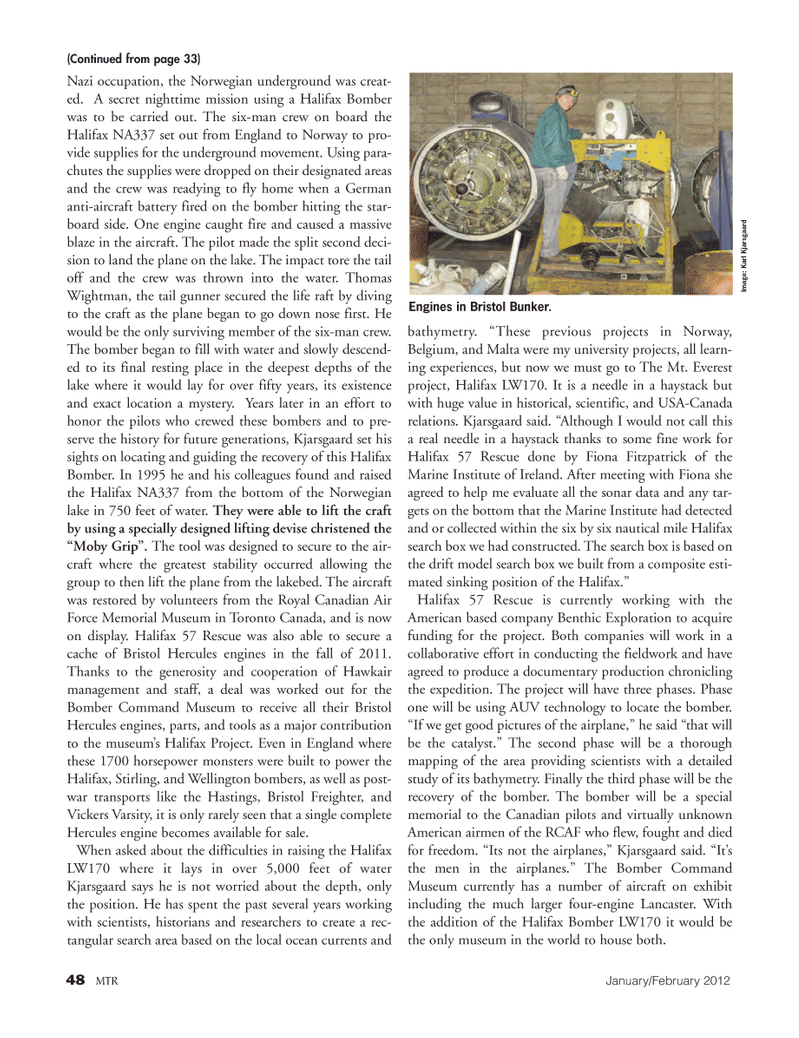
Page 48: of Marine Technology Magazine (January 2012)
Offshore Inspection, Repair & Maintenance
Read this page in Pdf, Flash or Html5 edition of January 2012 Marine Technology Magazine
48MTRJanuary/February 2012 Nazi occupation, the Norwegian underground was creat- ed. A secret nighttime mission using a Halifax Bomber was to be carried out. The six-man crew on board the Halifax NA337 set out from England to Norway to pro- vide supplies for the underground movement. Using para- chutes the supplies were dropped on their designated areas and the crew was readying to fly home when a German anti-aircraft battery fired on the bomber hitting the star- board side. One engine caught fire and caused a massive blaze in the aircraft. The pilot made the split second deci- sion to land the plane on the lake. The impact tore the tail off and the crew was thrown into the water. Thomas Wightman, the tail gunner secured the life raft by diving to the craft as the plane began to go down nose first. He would be the only surviving member of the six-man crew. The bomber began to fill with water and slowly descend- ed to its final resting place in the deepest depths of the lake where it would lay for over fifty years, its existence and exact location a mystery. Years later in an effort to honor the pilots who crewed these bombers and to pre- serve the history for future generations, Kjarsgaard set his sights on locating and guiding the recovery of this Halifax Bomber. In 1995 he and his colleagues found and raised the Halifax NA337 from the bottom of the Norwegian lake in 750 feet of water. They were able to lift the craft by using a specially designed lifting devise christened the ?Moby Grip?. The tool was designed to secure to the air- craft where the greatest stability occurred allowing the group to then lift the plane from the lakebed. The aircraft was restored by volunteers from the Royal Canadian Air Force Memorial Museum in Toronto Canada, and is now on display. Halifax 57 Rescue was also able to secure a cache of Bristol Hercules engines in the fall of 2011. Thanks to the generosity and cooperation of Hawkair management and staff, a deal was worked out for the Bomber Command Museum to receive all their Bristol Hercules engines, parts, and tools as a major contribution to the museum?s Halifax Project. Even in England where these 1700 horsepower monsters were built to power the Halifax, Stirling, and Wellington bombers, as well as post- war transports like the Hastings, Bristol Freighter, and Vickers Varsity, it is only rarely seen that a single complete Hercules engine becomes available for sale. When asked about the difficulties in raising the Halifax LW170 where it lays in over 5,000 feet of water Kjarsgaard says he is not worried about the depth, only the position. He has spent the past several years working with scientists, historians and researchers to create a rec- tangular search area based on the local ocean currents and bathymetry. ?These previous projects in Norway, Belgium, and Malta were my university projects, all learn- ing experiences, but now we must go to The Mt. Everest project, Halifax LW170. It is a needle in a haystack but with huge value in historical, scientific, and USA-Canada relations. Kjarsgaard said. ?Although I would not call this a real needle in a haystack thanks to some fine work for Halifax 57 Rescue done by Fiona Fitzpatrick of the Marine Institute of Ireland. After meeting with Fiona she agreed to help me evaluate all the sonar data and any tar- gets on the bottom that the Marine Institute had detected and or collected within the six by six nautical mile Halifax search box we had constructed. The search box is based on the drift model search box we built from a composite esti- mated sinking position of the Halifax.? Halifax 57 Rescue is currently working with the American based company Benthic Exploration to acquire funding for the project. Both companies will work in a collaborative effort in conducting the fieldwork and have agreed to produce a documentary production chronicling the expedition. The project will have three phases. Phase one will be using AUV technology to locate the bomber. ?If we get good pictures of the airplane,? he said ?that will be the catalyst.? The second phase will be a thorough mapping of the area providing scientists with a detailed study of its bathymetry. Finally the third phase will be the recovery of the bomber. The bomber will be a special memorial to the Canadian pilots and virtually unknown American airmen of the RCAF who flew, fought and died for freedom. ?Its not the airplanes,? Kjarsgaard said. ?It?s the men in the airplanes.? The Bomber Command Museum currently has a number of aircraft on exhibit including the much larger four-engine Lancaster. With the addition of the Halifax Bomber LW170 it would be the only museum in the world to house both.Engines in Bristol Bunker. Image: Karl Kjarsgaard (Continued from page 33)MTR#1 (34-48):MTR Layouts 1/3/2012 11:07 AM Page 48

 47
47

 3rd Cover
3rd Cover
